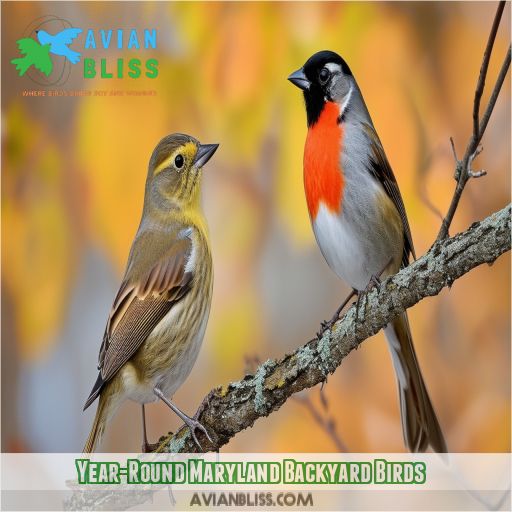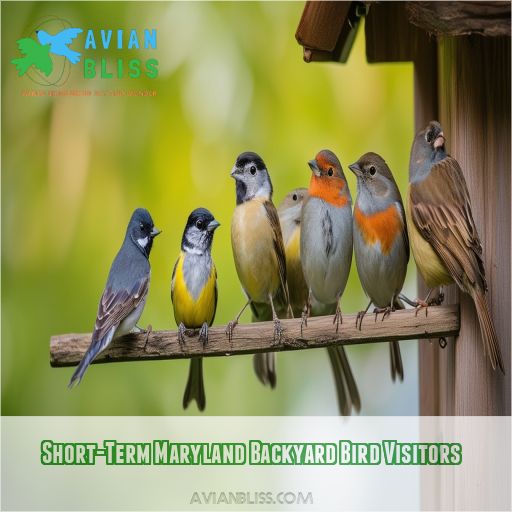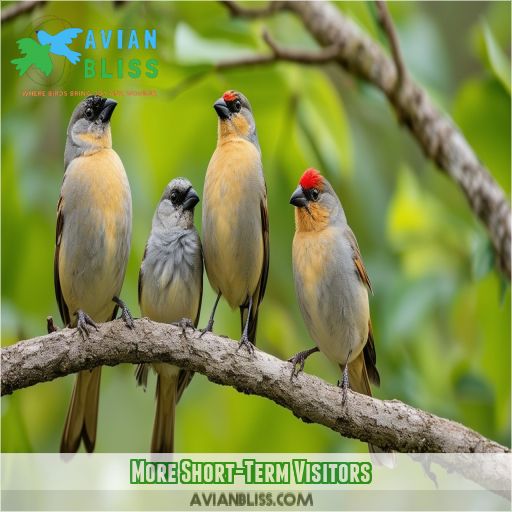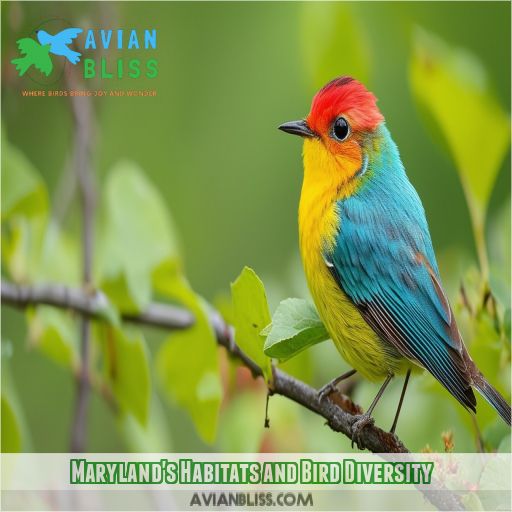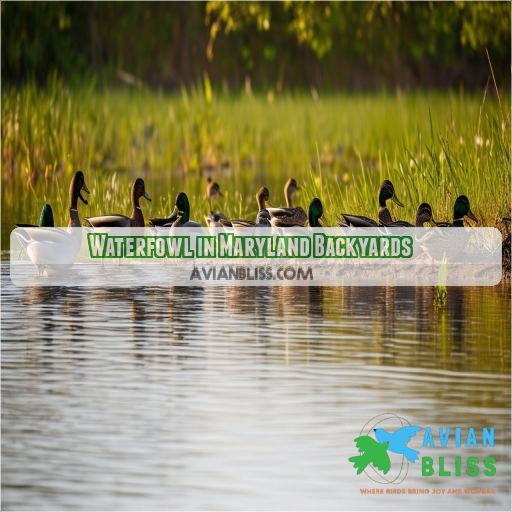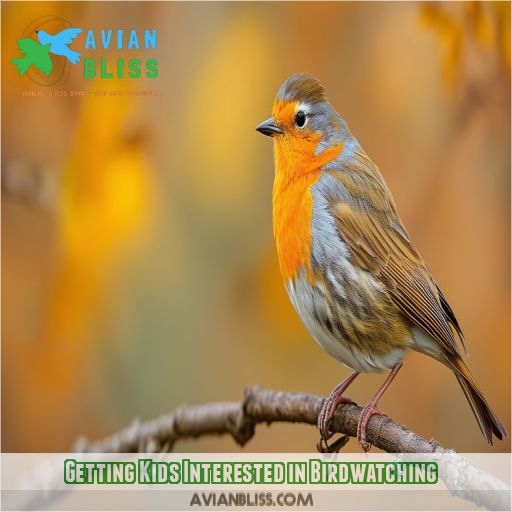This site is supported by our readers. We may earn a commission, at no cost to you, if you purchase through links.

Curious for more? Keep going to uncover more birding treasures.
Table Of Contents
- Key Takeaways
- Year-Round Maryland Backyard Birds
- Seasonal Maryland Backyard Birds
- Short-Term Maryland Backyard Bird Visitors
- More Short-Term Visitors
- Maryland’s Habitats and Bird Diversity
- Identifying Backyard Birds in Maryland
- Waterfowl in Maryland Backyards
- Raptors and Predatory Birds in Maryland
- Getting Kids Interested in Birdwatching
- Frequently Asked Questions (FAQs)
- How do I identify a bird in my backyard?
- What is the most common bird in Maryland?
- What are the small GREY birds in Maryland?
- What is the MD state bird?
- What birds are rare in Maryland?
- What are the most common backyard birds in Maryland in winter?
- What birds are in a Maryland yard?
- Are mockingbirds common in Maryland?
- Which bird feeder attracts the most birds in Maryland?
- What do acrobatic birds look like in Maryland?
- How do I attract hummingbirds to my yard?
- What is the average lifespan of backyard birds?
- How can I create a bird-friendly garden?
- What are the benefits of birdwatching?
- How do birds communicate with each other?
- Conclusion
Key Takeaways
- Get ready for a feathered extravaganza in your own backyard, Maryland! With over 453 bird species recorded, there’s a colorful cast of characters just waiting to visit your bird feeders and entertain you with their antics.
- Maryland’s diverse habitats, from woodlands to marshes, are a haven for feathered friends. Whether you’re a seasoned birdwatcher or just starting to explore the world of birds, there’s something for everyone to enjoy.
- Don’t miss the chance to spot the state bird, the Baltimore Oriole, with its striking golden-orange and black plumage. It’s a symbol of Maryland’s rich avian diversity and a treat to see in your backyard.
- Get involved in birdwatching with your kids! It’s a great way to connect with nature, teach them about the environment, and create lasting memories together.
Year-Round Maryland Backyard Birds
You’ll find several bird species that call Maryland home year-round, including the vibrant Northern Cardinal, the striking Blue Jay, and the gentle Mourning Dove. American Goldfinches and House Finches also remain in the state throughout the seasons, offering a consistent display of avian activity in your backyard.
Northern Cardinal
You’ll spot the Northern Cardinal year-round in Maryland, its vibrant red plumage a striking sight against any backdrop. This beloved bird’s crest and black face mask make it unmistakable. Cardinals prefer dense shrubs and low trees, often visiting feeders alongside house finches and tufted titmice. Listen for their clear, whistling song – a cheerful "cheer-cheer-cheer" that brightens your backyard soundscape.
Blue Jay
You’ll often spot the vibrant Blue Jay in your Maryland backyard year-round. These intelligent birds are known for their striking blue plumage and loud calls. They’re highly adaptable and thrive in various habitats, including suburban areas. Blue Jays are omnivorous, eating seeds, nuts, and insects.
Their territorial nature is evident in:
- Aggressive defense of nesting sites
- Mobbing behavior against predators
- Loud, scolding calls to alert others
- Strategic food caching for future use
Mourning Dove
Unlike the bold Blue Jay, you’ll find Mourning Doves more subdued. These gentle birds are year-round residents in Maryland’s backyards. Their soft cooing adds a peaceful ambiance to your garden. Let’s explore some key facts about these common visitors:
| Characteristic | Description | Maryland Relevance |
|---|---|---|
| Appearance | Plump body, small head | Easily spotted on feeders |
| Habitat | Open areas, suburbs | Thrives in MD backyards |
| Diet | Seeds, grains | Platform feeders attract |
| Vocalizations | Soft, mournful coo | Distinct from Chipping Sparrow |
| Behavior | Ground foragers | Often seen with other birds |
American Goldfinch
You’ll love spotting American goldfinches in your Maryland backyard! These bright yellow birds are a year-round treat.
They’re not just pretty faces; their diet is quite unique. Unlike their feathered friends like the house wren or eastern bluebird, goldfinches primarily feast on seeds.
You’ll often see them flitting about with American robins and song sparrows, adding a splash of sunshine to your garden.
House Finch
While the American Goldfinch dazzles with its bright yellow plumage, you’ll find the House Finch equally charming. These year-round residents sport a rosy-red head and breast, though females are more subdued. You’ll often hear their cheerful warbling song.
Unlike European starlings, House Finches prefer seeds and fruits. They’re adaptable, nesting in various locations from trees to hanging planters, making them frequent visitors to Maryland backyards.
Seasonal Maryland Backyard Birds
You’ll find several seasonal visitors gracing Maryland’s backyards throughout the year. White-throated sparrows and dark-eyed juncos arrive in October, while chipping sparrows and the melodious eastern wood peewee make their appearance in spring, joining the year-round house sparrow population.
White-Throated Sparrow
You’ll spot white-throated sparrows in your Maryland backyard come October. These striking birds, with their distinctive white throat patch, migrate south for winter.
They’ll forage on the ground, feasting on seeds and insects. Listen for their sweet "Old Sam Peabody" whistle.
While not as showy as cardinals or blue jays, these sparrows add charm to your winter landscape. Keep an eye out near shrubs and feeders!
Dark-Eyed Junco
As fall migration brings the White-throated Sparrow, you’ll also notice another winter visitor: the Dark-eyed Junco. These slate-gray birds with white bellies arrive in October, joining the diverse cast of Maryland’s backyard avian residents.
Unlike their larger cousins, the American Crow and Fish Crow, juncos prefer ground feeding. You’ll often spot them hopping beneath your feeders, a charming contrast to the Canada Goose or Great Blue Heron in nearby waters.
Chipping Sparrow
While dark-eyed juncos retreat northward, chipping sparrows arrive to grace your Maryland backyard. You’ll recognize these charming birds by their:
- Rusty-red cap
- Bold white eyebrow
- Black line through the eye
- Grayish breast and underparts
Their distinctive trill, often likened to a sewing machine, fills the air. Chipping sparrows build cup-shaped nests in trees or shrubs, sometimes falling prey to brown-headed cowbird nest parasitism. Watch for their ground-foraging behavior as they search for seeds and insects.
House Sparrow
Unlike the Chipping Sparrow, you’ll find House Sparrows in your Maryland backyard year-round. These common birds have adapted well to urban environments, making them frequent visitors to feeders. Their seed-eating habits and widespread distribution make them easy to spot. Here’s a quick comparison of the House Sparrow with other common backyard species:
| Species | Coloration | Diet | Nest Location |
|---|---|---|---|
| House Sparrow | Brown, gray | Seeds, scraps | Buildings, trees |
| Northern Flicker | Brown, spotted | Insects, fruits | Tree cavities |
| Gray Catbird | Gray | Insects, berries | Shrubs, thickets |
| Northern Mockingbird | Gray, white patches | Insects, fruits | Trees, shrubs |
Eastern Wood Peewee
Unlike the gregarious House Sparrow, you’ll find the Eastern Wood Pewee more elusive. This migratory flycatcher arrives in spring, filling your backyard with its distinctive "pee-a-wee" song.
Watch for its olive-gray plumage as it perches on exposed branches, darting out to catch insects mid-air.
While not as common as the Baltimore Oriole or Pileated Woodpecker, spotting this bird adds excitement to your backyard birdwatching adventures.
Short-Term Maryland Backyard Bird Visitors
You’ll find several fascinating short-term visitors in your Maryland backyard throughout the year. Keep an eye out for the melodious Gray Catbird, the distinctive Yellow-Bellied Sapsucker, the opportunistic Brown-Headed Cowbird, the talented mimic Northern Mockingbird, and the colorful Rose-Breasted Grosbeak.
Gray Catbird
You’ll spot the gray catbird in your Maryland backyard come spring. These short-term visitors are known for their distinctive mewing call and slate-gray plumage. To attract them:
- Plant dense shrubs for nesting
- Offer fruit feeders with berries
- Maintain a water source
Listen for their varied songs, which include imitations of other birds. They prefer wooded areas near open spaces, making suburban Baltimore yards ideal habitats.
Yellow-Bellied Sapsucker
While the Gray Catbird may have flown south, you might spot a Yellow-bellied Sapsucker in your Maryland yard during winter.
These migratory woodpeckers, with their distinctive yellow bellies and red crowns, are masters of sap extraction. They’ll drill neat rows of holes in trees, creating their own natural feeders.
Keep an eye out for their methodical feeding habits, especially on maple or birch trees.
Brown-Headed Cowbird
You might spot the Brown-headed Cowbird in your Maryland backyard, a unique visitor with intriguing behavior.
Unlike other birds, cowbirds don’t build nests. Instead, they lay eggs in other birds’ nests, a practice called brood parasitism. This impacts host species’ populations.
Recognize them by their brown heads, black bodies, and distinctive "glug-glug-gleeee" song.
While not year-round residents, they’re more common than Black Vultures at Point Lookout State Park.
Northern Mockingbird
You’ll likely spot the Northern Mockingbird in your Maryland backyard as a short-term visitor. These skilled mimics are known for their:
- Diverse repertoire of songs, imitating other birds and even mechanical sounds
- Gray plumage with distinctive white wing patches and long tail
- Aggressive defense of their territory, especially during nesting season
Keep an eye out for their acrobatic flights and listen for their complex vocalizations as they flit through your garden.
Rose-Breasted Grosbeak
While mockingbirds mimic other birds, you’ll be thrilled to spot a Rose-breasted Grosbeak in your Maryland backyard. These stunning visitors have distinctive black-and-white plumage and rosy red breasts.
Rose-breasted Grosbeaks have unique nesting behaviors and song patterns. They prefer woodland edges and open areas, making your yard an ideal pit stop during their migratory routes.
Listen for their robin-like warble as they feast on seeds and insects.
More Short-Term Visitors
You’ll find even more short-term visitors in your Maryland backyard, including the Ruby-Crowned Kinglet, Blue-Gray Gnatcatcher, Palm Warbler, Yellow-Rumped Warbler, and Cedar Waxwing. These birds have distinct patterns of appearance, with some migrating through the state and others forming flocks during specific seasons.
Ruby-Crowned Kinglet
As you continue observing Maryland’s short-term visitors, you’ll want to keep an eye out for the Ruby-crowned Kinglet. This tiny, olive-green bird is a winter resident, migrating from its northern breeding grounds.
You’ll spot it flitting energetically through trees and shrubs, constantly flicking its wings. Its namesake ruby crown is often hidden, only flashing when the bird is excited or agitated.
Conservation efforts focus on protecting its diverse habitats.
Blue-Gray Gnatcatcher
Next up, the Blue-Gray Gnatcatcher. This tiny, energetic bird with its striking blue-gray feathers is a short-term visitor you’ll spot flitting about your yard. They often arrive during spring migration and stick around for their nesting season, filling your garden with their sharp, insistent calls. Look out for:
- Small, agile movements.
- Nesting in trees.
- Preference for insects.
Palm Warbler
The Palm Warbler, a fleeting visitor, can be spotted during their migration through Maryland’s backyards. Preferring shrubby environments and open woods, these small songbirds are often seen bobbing their tails as they forage for insects and berries. Their vibrant yellow underparts make them a delight to spot. Conservation efforts help maintain their habitats during migration seasons.
Yellow-Rumped Warbler
The Yellow-Rumped Warbler is a fascinating short-term visitor in Maryland. Recognized by its bright winter plumage, this bird has unique migrating habits, often found in wooded areas. Its nesting behavior involves building cup-shaped nests in coniferous trees. You can enjoy their melodic song recordings as they frequent your yard, particularly if you have shrubs and open spaces they prefer.
Cedar Waxwing
In winter, you’ll spot Cedar Waxwings in flocks, often feasting on berries. Their nomadic lifestyle means they move frequently, following food sources. Listen for their high-pitched vocalizations, a distinct giveaway to their presence. They breed late, allowing abundant food for their young. Their sleek, colorful appearance is a delightful addition to any Maryland backyard.
Maryland’s Habitats and Bird Diversity
Maryland’s diverse habitats, from hardwood woodlands to saltmarshes, provide a unique environment that supports a wide variety of bird species. The Baltimore Oriole, Maryland’s state bird since 1947, stands out with its striking golden-orange and black plumage, symbolizing the rich avian life the state hosts.
Maryland’s Diverse Habitats
Maryland’s bird habitats, from hardwood woodlands to saltmarshes, create a rich environment for bird species diversity. Backyard birdwatching is enhanced by:
- Mature trees providing nesting sites and shelter.
- Marshy ponds attracting waterfowl.
- Dead snags home to woodpeckers and cavity dwellers.
- Open grass areas housing various songbirds.
You’ll find unique Maryland birds thriving in these diverse settings.
Maryland’s State Bird: Baltimore Oriole
The Baltimore Oriole, Maryland’s state bird, flaunts stunning golden-orange and black plumage. Admire their graceful presence, especially around spring when they return from migration. These orioles, connected to the Calvert family crest, thrive in Maryland’s rich habitats, feeding on nectar, insects, and ripe fruits.
| Trait | Detail |
|---|---|
| Color | Golden Orange, Black Plumage |
| Diet | Nectar, Insects, Ripe Fruits |
| Habitat | Maryland’s Diverse Landscapes |
| Migration | Spring Migration Return |
Top Birding Spots in Maryland
Maryland offers exceptional birdwatching destinations. Point Lookout State Park hosts over 290 species due to diverse habitats for birds. Sandy Point State Park boasts numerous backyard birds, ideal for casual observation. Assateague Island National Seashore provides year-round birdwatching opportunities. Conservation efforts support variety of species, ensuring these locations remain premier sites for enthusiasts seeking varied birdwatching experiences.
Backyard Bird Count in Maryland
Maryland’s habitat diversity supports an impressive bird count of approximately 453 backyard species. Conservation efforts and the presence of backyard feeders enhance species richness. Key highlights include:
- Worcester, Baltimore, and Anne Arundel counties boasting the highest diversity.
- Point Lookout State Park recording 299 species.
- Various habitats from hardwood woodlands to saltmarshes contributing to this abundance.
Common Backyard Birds in Maryland
Maryland’s backyard is a birdwatcher’s paradise, with diverse habitats supporting many common species. Keep an eye out for vibrant Northern Cardinals, Blue Jays, American Goldfinches, and Mourning Doves. Enhance your birdwatching tips with proper feeder placement, and use bird identification apps for accurate spotting.
| Bird Species | Habitat | Season |
|---|---|---|
| Northern Cardinal | Bushes, edges | Year-round |
| Blue Jay | Forests, suburbs | Year-round |
| Mourning Dove | Open areas, gardens | Year-round |
| American Goldfinch | Fields, feeders | Year-round |
Identifying Backyard Birds in Maryland
When identifying backyard birds in Maryland, you’ll encounter a variety of species. The American Crow is known for its intelligence and adaptability. The Red-bellied Woodpecker is easily spotted by its vibrant red cap and unique drumming sound.
Other common visitors include the Song Sparrow with its melodious tune. The agile White-breasted Nuthatch and the soaring Turkey Vulture each add to the rich avian diversity in your garden.
American Crow
Spotting an American crow in your Maryland backyard is a treat. You’ll recognize it by its striking black plumage and large size. These crows exhibit intelligent behavior, often seen using tools or solving problems. With an omnivorous diet, they consume a variety of foods, from insects to seeds. Their signature loud cawing is unmistakable.
Red-bellied Woodpecker
Moving from the crow’s caw, let’s penetrate into identifying the Red-bellied Woodpecker. With its striking black-and-white barred back and a hint of red on its belly, it thrives in woodpecker habitats like mature trees. Its foraging behavior includes drilling into bark for insects. Nesting in tree cavities, you’ll hear its distinctive, rolling calls echo around your backyard feeders.
Song Sparrow
Next, let’s explore the Song Sparrow. You’ll often find them in open fields and marshes, singing from perches. Their diet consists of seeds, grains, and insects.
- Song Sparrow Habitat: Prefers open fields, marshes, and shrublands.
- Song Sparrow Diet: Mostly seeds and grains, with some insects.
- Song Sparrow Behavior: Known for their melodic songs, especially during mating season.
White-breasted Nuthatch
Moving from the Song Sparrow, you’ll often spot the White-breasted Nuthatch in your Maryland backyard. This agile bird, known for its distinctive foraging habits, climbs tree trunks headfirst. Their nesting behavior includes using tree cavities, and they’ve a unique, nasal call. Preferring mature woods and feeders, they create a lively atmosphere.
| Feature | Description |
|---|---|
| Appearance | White breast, blue-gray back |
| Voice | Nasal "yank-yank" |
| Habitat | Mature trees, suburban yards |
| Diet | Insects, seeds, suet |
| Nesting | Cavities in dead trees |
Turkey Vulture
Moving from the White-breasted Nuthatch, let’s encounter the Turkey Vulture. Identifiable by its featherless crimson head and extensive wings, it glides above with minimal wing movement. Often discovered near animal carcasses, this garbage collector‘s sustenance primarily comprises dead animals. Prevalent in diverse environments, ranging from woodlands to residential areas, Turkey Vultures serve a vital function in maintaining environmental cleanliness.
Waterfowl in Maryland Backyards
You can spot waterfowl like Canada Geese and Mallards in your Maryland backyard, especially near ponds or marshy areas. Look out for Great Blue Herons and Bald Eagles as well, often seen hunting or wading in wetland habitats.
Canada Goose
Spotting a Canada Goose in your Maryland backyard is thrilling. These waterfowl prefer marshy ponds, making your neighborhood ideal. With a distinct honk, their behavior includes grazing on grass and aquatic plants. Watch their seasonal migration patterns, as they travel in iconic V-formations. A thriving Canada Goose population guarantees you’re never alone when observing these remarkable birds.
Mallard
In your Maryland backyard, you’re likely to spot Mallards in nearby ponds or marshy areas. These ducks are known for their distinctive green heads and yellow beaks. Their habitat consists of freshwater bodies. Mallard migration occurs in spring and fall. They feed on seeds, aquatic vegetation, and insects. Breeding season sees them nesting near water, promoting conservation efforts.
Great Blue Heron
The great blue heron is a majestic bird you’ll often spot near water in Maryland backyards. With its impressive wingspan and stealthy fishing habits, it expertly hunts fish and amphibians. Watch for their:
- Graceful flight patterns
- Unique nesting sites in trees
- Seasonal migration movements
- Year-round presence in milder climates
- Key role in ecosystem conservation
Red-winged Blackbird
The Red-winged Blackbird, common in Maryland’s saltmarshes and backyards, adds a vibrant touch with its distinct red and yellow shoulder patches. This bird’s sharp "conk-la-ree" call is unmistakable, especially in spring.
| Observation Tips | Habitat | Behavior | Migration | Diet |
|---|---|---|---|---|
| Use binoculars | Saltmarshes | Aggressive | Partial migrant | Insects |
| Enjoy early mornings | Wetlands | Territorial | North in summer | Seeds |
| Patient observation | Suburban areas | Nesting near water | South in winter | Grains |
| Listen for calls | Meadows | Vocal | Spiders | |
| Watch for displays | Fields | Social in winter | Small animals |
Bald Eagle
Spotting a Bald Eagle in your Maryland backyard is awe-inspiring. With their massive wingspan, they’re iconic symbols of freedom. You might see them nesting near large bodies of water. Habitat conservation efforts have helped, increasing their sightings. They feed on fish and small mammals, and observing their migration patterns can be a thrill for any bird enthusiast.
Raptors and Predatory Birds in Maryland
Spotting raptors and predatory birds in your Maryland backyard can be a thrilling experience. Keep an eye out for the Red-shouldered Hawk, the impressive Pileated Woodpecker, the scavenging Black Vulture, and the striking Northern Flicker.
Red-shouldered Hawk
The Red-shouldered Hawk is a striking raptor you might spot in your Maryland backyard.
- Habitat: Prefers mixed woodlands with water sources nearby.
- Diet: Feeds on small mammals, amphibians, and reptiles.
- Lifespan: Can live up to 15-20 years in the wild.
Their call is a distinctive, high-pitched whistle, often heard before seen.
Pileated Woodpecker
Changing from the Red-shouldered Hawk, let’s explore the Pileated Woodpecker. In Maryland, these striking birds reside in mature forests, preferring dead snags. They consume insects, primarily carpenter ants. Nesting in tree cavities, they breed from late winter to early summer. Conservation efforts guarantee their habitats are protected, maintaining their significant role in the ecosystem.
Black Vulture
Spotting a Black Vulture in your Maryland backyard is a treat! With its impressive wingspan, this scavenger plays a critical role in cleaning up the environment by consuming carrion. Here are key features:
- Wingspan: Reaches up to 5 feet.
- Feeding Habits: Prefers carrion.
- Nesting Behavior: Nests in hollow trees.
- Conservation Status: Least concern.
Northern Flicker
Spot the Northern Flicker in your backyard. Its habitat spans forests, open woods, and suburban areas. Nesting in tree cavities, it prefers ants and beetles for food. Migration patterns vary; some stay year-round, while others migrate south. Check out the table for more insight:
| Feature | Description |
|---|---|
| Habitat | Forests, suburban areas |
| Nesting | Tree cavities |
| Food | Ants, beetles |
Discover this fascinating bird in your own garden!
Getting Kids Interested in Birdwatching
Start by involving kids in birdwatching through simple activities like keeping a bird journal or making homemade bird feeders, and gradually introduce them to the most common spots for bird watching in Maryland. Highlight the excitement of a backyard bird count, encouraging curiosity by identifying top birds they might see right in their own garden.
The Most Common Spots for Bird Watching in Maryland
Want to spark your child’s interest in birdwatching? Visit these top birding locations in Maryland:
- Point Lookout State Park offers diverse bird species and a scenic environment.
- Sandy Point State Park features many backyard birds and beautiful waterfront views.
- Assateague Island National Seashore with exceptional year-round birdwatching opportunities.
These birding hotspots provide ideal wildlife watching destinations.
Backyard Bird Count of Maryland
Get your kids excited about birdwatching by exploring Maryland’s backyard bird diversity! With over 453 species, Worcester, Baltimore, and Anne Arundel counties have the highest diversity. Point Lookout State Park holds the record with 299 species. Join the fun and start counting!
| County | Species Count | Notable Birds |
|---|---|---|
| Worcester | 245 | Osprey, Prothonotary Warbler |
| Baltimore | 230 | Carolina Chickadee, Eastern Bluebird |
| Anne Arundel | 220 | Tufted Titmouse, American Goldfinch |
Top Backyard Birds to See in Maryland
When exploring Maryland’s top backyard birds with kids, you create lifelong memories. Focus on these key areas:
- Backyard Habitats: Provide diverse plantings and water sources.
- Feeding Strategies: Use varied feeders, including suet and nectar.
- Conservation Efforts: Teach respect for nature and sustainable practices.
- Birding Etiquette: Encourage patience and quiet observation, enhancing birdwatching experiences.
The Most Common Backyard Birds to See in Maryland
One of the most common backyard experiences in Maryland is birdwatching. You’ll notice Northern Cardinals and Blue Jays frequenting feeders, likely drawn to the mix of sunflower seeds and cracked corn on tray feeders attract blue jays to your yard, enjoying seasonal bird migration moments. Encourage kids by setting up varied birdwatching habitats and using bird feeding tips; challenge them to identify species, sparking curiosity and a lifelong appreciation for nature. Happy backyard birding!
Frequently Asked Questions (FAQs)
How do I identify a bird in my backyard?
Around 453 bird species frequent Maryland backyards. Use a field guide or a bird identification app, noting features like size, color, and song. Platform feeders and birdbaths can attract a diverse bird population for observation.
What is the most common bird in Maryland?
The Northern Cardinal is the most common bird you’ll find in Maryland. Its bright red plumage, distinct crest, and sweet whistles make it a frequent and welcomed visitor in suburban backyards year-round.
What are the small GREY birds in Maryland?
In Maryland, small gray birds you might spot include the Tufted Titmouse, with its black eyes and crested head, and the Gray Catbird, known for its mimicking songs and sleek, uniform gray plumage.
What is the MD state bird?
The vibrant Baltimore Oriole, symbolizing Maryland’s rich avian diversity, is your state bird. Its striking golden-orange and black plumage mirrors the state’s dedication to natural beauty, echoing the historic Calvert family crest.
What birds are rare in Maryland?
In Maryland, rare bird sightings include the Painted Bunting, Kirtland’s Warbler, and Black Rail. These species are uncommon due to their specific habitat needs, migratory patterns, and limited population sizes within the state.
What are the most common backyard birds in Maryland in winter?
In Maryland’s winter, you’ll most commonly spot Northern Cardinals, Blue Jays, Mourning Doves, American Goldfinches, and House Finches in your backyard, adding vibrant colors and lively sounds to the cold, quiet months.
What birds are in a Maryland yard?
In a Maryland yard, you’ll find Northern Cardinals like precious gems in a crown, Blue Jays, American Goldfinches, Mourning Doves, and House Finches year-round. Seasonally, you’ll also spot White-Throated Sparrows and Dark-Eyed Juncos.
Are mockingbirds common in Maryland?
Yes, Northern Mockingbirds are common in Maryland. You can spot them in your yard, particularly in suburban areas with mature trees and open spaces. Their distinctive songs and mimicry make them easy to recognize.
Which bird feeder attracts the most birds in Maryland?
Consider a platform feeder. It attracts a variety of birds like Northern Cardinals, Blue Jays, and even Mourning Doves, making your backyard a microcosm of Maryland’s avian diversity, bustling with species year-round and seasonally.
What do acrobatic birds look like in Maryland?
Acrobatic birds in Maryland, like the Carolina Chickadee and Tufted Titmouse, showcase agile movements. These small, energetic songbirds are noted for flitting between feeders and trees, demonstrating remarkable aerial skill and maneuverability.
How do I attract hummingbirds to my yard?
Plant nectar-rich flowers like red salvia, use hummingbird feeders with sugar water, and provide perches. Guarantee fresh water and avoid pesticides. Keep feeders clean, and you’ll soon see these tiny jewels dancing in your yard.
What is the average lifespan of backyard birds?
Backyard birds like Northern Cardinals and American Goldfinches generally live 3–5 years, while Mourning Doves average 5 years. Some species, like the American Crow, can live up to 15 years, depending on environmental factors.
How can I create a bird-friendly garden?
To create a haven for birds, plant native flora, offer diverse feeders, fresh water sources, and shelter. Maintain birdbaths, provide nesting materials, and avoid pesticides. Your garden will soon be an avian sanctuary.
What are the benefits of birdwatching?
Birdwatching enhances mental well-being, reduces stress, and fosters a connection to nature. You develop observation skills, identify bird species, and engage in a peaceful, fulfilling hobby that promotes conservation awareness and environmental stewardship.
How do birds communicate with each other?
Birds communicate using songs, calls, and body language. Songs attract mates and defend territories, while calls warn of danger and coordinate group movements. Body language, like feather displays and specific postures, conveys intentions and social status.
Conclusion
Exploring the backyard birds of Maryland is like painting a living canvas with vibrant feathered hues. From year-round residents to seasonal visitors, understanding these birds enhances your connection to nature.
With diverse habitats and numerous species, there’s always something unique to observe. Equipped with this newfound knowledge, embrace birdwatching in your garden as both a delightful hobby and a scientific exploration.
Let every chirp and flutter remind you of Maryland’s rich avian life.

